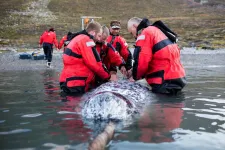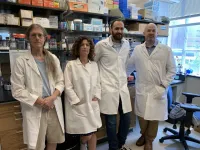Intestinal cancers: The 14-3-3sigma gene acts as a tumor suppressor
2021-06-16
(Press-News.org) LMU researchers have identified the 14-3-3sigma gene as an important suppressor of carcinogenesis in the gastrointestinal tract.
Intestinal cancers, also known as colorectal cancer, are among the most prevalent forms of malignancy worldwide. If detected early enough, tumors can be surgically excised. However, as cancer growth progresses, cells may escape from the primary tumor, which can then establish metastatic tumors in other organs. Once such satellite tumors have formed, survival rates fall significantly. Formation of the initial tumor can be triggered by mutations in any of a number of genes. Together with postdocs Markus Winter and Matjaž Rokavec, Professor Heiko Hermeking at LMU's Institute of Pathology has now discovered that a gene called 14-3-3sigma functions as a tumor suppressor in gastrointestinal cancers. Using the mouse as an experimental model, the team demonstrated that inactivation of the 14-3-3sigma gene enhance progression of gastrointestinal cancers and consequently shortens the lifespan of mice.
In earlier work with colon carcinoma cell lines, Hermeking and his colleagues had shown that a protein known as p53, which plays a central role in the suppression of many types of tumors, activates the 14-3-3sigma gene, and that its protein product inhibits passage through the cell cycle. This brake on cell division gives cells more time to repair adventitious or environmentally caused DNA damage, and therefore reduces the risk of uncontrolled cell proliferation. Mutations that inactivate p53 are found in more than half of all tumors. "But it was not clear whether the 14-3-3sigma gene itself plays an important role in the suppression of tumorigenesis in the intestine," says Hermeking.
In a project funded by the German Cancer Research Fund (Deutsche Krebshilfe), his team set out to clarify this issue by analyzing patterns of gene expression in several thousands of tumor samples isolated from patients with colorectal cancer. The data revealed that the expression of 14-3-3sigma is indeed significantly downregulated in these tumors. In addition, this effect was particularly pronounced in metastatic tumors, and the level of expression of the gene showed a negative correlation with the degree of cancer progression. Furthermore, patients with lower levels of expression of the 14-3-3sigma gene were found to have a worse prognosis than those with higher expression - and this finding was independent of whether or not the tumors also contained an inactivating mutation in the p53 gene.
To further explore the significance of 14-3-3sigma in intestinal carcinogenesis, the LMU researchers specifically inactivated the gene in a preclinical mouse model of intestinal cancer. Loss of the gene's function was found to stimulate the formation and growth of tumors in the gastrointestinal tract, and ultimately reduced survival times. Subsequent studies showed that, in the absence of the 14-3-3sigma gene, signaling pathways which are regulated by transcription factors that have been implicated in the formation of metastases are selectively induced. Interestingly, the 14-3-3sigma protein is known to bind and negatively regulate these transcription factors. "Taken together, our results demonstrate that 14-3-3sigma is not only one of the many target genes that are controlled by p53 and mediate its tumor-suppressing function, but also has tumor-suppressive functions on its own in the gastrointestinal tract," says Hermeking.
The authors of the study suggest that detection of decreased expression of the 14-3-3sigma gene in resected primary colon carcinomas could serve as a prognostic indicator in patient populations. "Moreover, the signaling pathways that are triggered upon its inactivation are potential targets for therapeutic interventions," Hermeking adds.
INFORMATION:
ELSE PRESS RELEASES FROM THIS DATE:
2021-06-16
CHAMPAIGN, Ill. -- Health care workers often don't adopt new guidelines for best practices in medical care until well after those guidelines are established. A team of researchers led by Eunice E. Santos, the dean of the School of Information Sciences at the University of Illinois Urbana-Champaign, has developed a new computational modeling and simulation framework to analyze decision-making and identify effective dissemination strategies for medical guidelines.
The research team examined guidelines for Type 2 diabetes that were established in 2012 and were still not adopted years later. The researchers found that health ...
2021-06-16
The lush forests and more than 7,000 islands of the Philippines hold a rich diversity of life, with 258 bird species who live nowhere but the Philippine archipelago. A new study from University of Utah researchers suggests that, due to deforestation and habitat degradation, more bird species may be endangered that previously thought - including species that may not have been discovered yet. The study is published in Frontiers in Ecology and Evolution.
"Our study provides a roadmap for not only which species may warrant heightened conservation attention," says Kyle Kittelberger, a doctoral student in the University of Utah School of Biological Sciences, "but which traits ...
2021-06-16
An algorithm can predict when narwhals hunt - a task once nearly impossible to gain insight into. Mathematicians and computer scientists at the University of Copenhagen, together with marine biologists in Greenland, have made progress in gathering knowledge about this enigmatic Arctic whale at a time when climate change is pressuring them.
The small whale, known for its distinctively spiraled tusk, is under mounting pressure due to warming waters and the subsequent increase in Arctic shipping traffic. To better care for narwhals, we need to learn more about their foraging behaviour - and how these may change as a result of human disturbances and global warming. Biologists know almost nothing about this. Because narwhals live in isolated Arctic regions and ...
2021-06-16
For many of us, our smartphone has become our ever-present companion and is usually far more than just a phone. Thanks to the constant availability of online content as well as our reachability through messenger services and social networks via our smartphone, this everyday object's potential to distract us is high - at work too. This is why many employers view the use of smartphones during work time with suspicion, and countermeasures taken range from asking staff to refrain voluntarily from using them to banning smartphones in the workplace through an internal agreement. But do such measures actually work and, if so, how?
This is the ...
2021-06-16
DURHAM, N.C. - Special diets, exercise programs, supplements and vitamins -- everywhere we look there is something supposed to help us live longer. Maybe those work: human average life expectancy has gone from a meager 40-ish years to a whopping 70-something since 1850. Does this mean we are slowing down death?
A new study comparing data from nine human populations and 30 populations of non-human primates says that we are probably not cheating the reaper. The researchers say the increase in human life expectancy is more likely the statistical outcome of improved survival for children and young adults, not slowing the aging clock.
"Populations get older mostly because more individuals get through those early stages of life," ...
2021-06-16
In the majority of insects, metamorphosis fosters completely different looking larval and adult stages. For example, adult butterflies are completely different from their larval counterparts, termed caterpillars. This "decoupling" of life stages is thought to allow for adaptation to different environments. Researchers of the University of Bonn now falsified this text book knowledge of evolutionary theory for stoneflies. They found that the ecology of the larvae largely determines the morphology of the adults by investigating 219 earwig and stonefly species at high-resolution particle accelerators. The study has ...
2021-06-16
Osteoporosis researchers at the UVA School of Medicine have taken a new approach to understanding how our genes determine the strength of our bones, allowing them to identify several genes not previously known to influence bone density and, ultimately, our risk of fracture.
The work offers important insights into osteoporosis, a condition that affects 10 million Americans, and it provides scientists potential new targets in their battle against the brittle-bone disease.
Importantly, the approach uses a newly created population of laboratory mice that allows researchers to identify relevant genes and overcome limitations of human studies. Identifying such genes has been very difficult but is key to using genetic discoveries to improve ...
2021-06-16
Woods Hole, MA (June 16, 2021) -- Woods Hole Oceanographic Institution (WHOI) climate modeler Dr. Alan Condron and United States Geological Survey (USGS) research geologist Dr. Jenna Hill have found evidence that massive icebergs from roughly 31,000 years ago drifted more than 5000km (> 3,000 miles) along the eastern United States coast from Northeast Canada all the way to southern Florida. These findings were published today in Nature Communications.
Using high resolution seafloor mapping, radiocarbon dating and a new iceberg model, the team analyzed about 700 iceberg scours ("plow marks" on the seafloor left behind by the bottom parts of icebergs dragging through marine sediment ) from Cape Hatteras, North Carolina to the Florida Keys. ...
2021-06-16
Researchers from the Max-Planck Institute for Terrestrial Microbiology have discovered a surprising asymmetry in the mating behavior of unicellular yeast that emerges solely from molecular differences in pheromone signaling. Their results, published in the current issue of "Science Advances", might shed new light on the evolutionary origins of sexual dimorphism in higher eukaryotes.
Resemblant of higher organisms, yeast gametes communicate during the mating process by secreting and sensing sexual pheromones. However, in contrast to higher eukaryotes, budding yeast is isogamous: seen through a microscope, gametes of both mating types ("sexes"), MATa and MATα, look exactly the same. Since anisogamy -- difference in size between male and female gametes --was ...
2021-06-16
HOUSTON ? The University of Texas MD Anderson Cancer Center's Research Highlights provides a glimpse into recently published studies in basic, translational and clinical cancer research from MD Anderson experts. Current advances include a new combination therapy for acute myeloid leukemia (AML), a greater understanding of persistent conditions after AML remission, the discovery of a universal biomarker for exosomes, the identification of a tumor suppressor gene in hepatocellular carcinoma (HCC) and characterization of a new target to treat Clostridioides difficile (C. difficile) infections.
Utilizing combination therapy for AML
While a majority of patients with acute myeloid leukemia (AML) respond favorably ...
LAST 30 PRESS RELEASES:
[Press-News.org] Intestinal cancers: The 14-3-3sigma gene acts as a tumor suppressor







